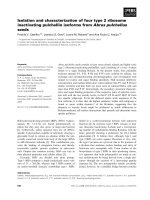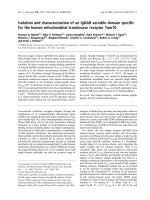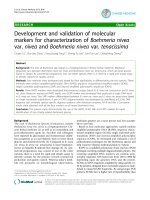isolation and characterization of microsatellite markers for jasminum sambac oleaceae using illumina shotgun sequencing
Bạn đang xem bản rút gọn của tài liệu. Xem và tải ngay bản đầy đủ của tài liệu tại đây (498.54 KB, 4 trang )
Isolation and Characterization of Microsatellite Markers for Jasminum sambac
(Oleaceae) Using Illumina Shotgun Sequencing
Author(s): Yong Li and Weirui Zhang
Source: Applications in Plant Sciences, 3(10)
Published By: Botanical Society of America
DOI: />URL: />
BioOne (www.bioone.org) is a nonprofit, online aggregation of core research in the biological, ecological, and
environmental sciences. BioOne provides a sustainable online platform for over 170 journals and books published
by nonprofit societies, associations, museums, institutions, and presses.
Your use of this PDF, the BioOne Web site, and all posted and associated content indicates your acceptance of
BioOne’s Terms of Use, available at www.bioone.org/page/terms_of_use.
Usage of BioOne content is strictly limited to personal, educational, and non-commercial use. Commercial inquiries
or rights and permissions requests should be directed to the individual publisher as copyright holder.
BioOne sees sustainable scholarly publishing as an inherently collaborative enterprise connecting authors, nonprofit publishers, academic institutions, research
libraries, and research funders in the common goal of maximizing access to critical research.
Applications in Plant Sciences 2015 3(10): 1500063
Applicati
Ap
tions
ons
in Pl
Plantt Scien
Sciences
ces
PRIMER NOTE
ISOLATION AND CHARACTERIZATION OF MICROSATELLITE
MARKERS FOR JASMINUM SAMBAC (OLEACEAE) USING ILLUMINA
SHOTGUN SEQUENCING1
YONG LI2,4,5 AND WEIRUI ZHANG3,4
2College
of Forestry, Henan Agricultural University, Zhengzhou 450002, People’s Republic of China; and 3Institute of Chinese
Materia Medica, Henan University, Kaifeng 475004, People’s Republic of China
• Premise of the study: Microsatellite markers of Jasminum sambac (Oleaceae) were isolated to investigate wild germplasm resources and provide markers for breeding.
• Methods and Results: Illumina sequencing was used to isolate microsatellite markers from the transcriptome of J. sambac. A
total of 1322 microsatellites were identified from 49,772 assembled unigenes. One hundred primer pairs were randomly selected to verify primer amplification efficiency. Out of these tested primer pairs, 31 were successfully amplified: 18 primer
pairs yielded a single allele, seven exhibited fixed heterozygosity with two alleles, and only six displayed polymorphisms.
• Conclusions: This study obtained the first set of microsatellite markers for J. sambac, which will be helpful for the assessment
of wild germplasm resources and the development of molecular marker–assisted breeding.
Key words: Illumina sequencing; Jasminum sambac; microsatellite markers; Oleaceae.
Jasminum sambac (L.) Aiton (Oleaceae) is an evergreen
vine or shrub that is native to Pakistan and India; this species
is cultivated as an ornamental plant worldwide because of its
attractive and sweet fragrance (Ruan, 2014). Previous studies on this plant have mainly focused on its aromatic compounds (Edris et al., 2008), medicinal values (Sengar et al.,
2015), cultivation physiology (He et al., 2010), and aromatic
gene isolation (Ou, 2012; Sun et al., 2014). Only one study
has reported the genetic diversity of J. sambac using intersimple sequence repeat (ISSR) markers (Qiu et al., 2008).
However, ISSR loci are dominant markers that are difficult
to use in the calculation of heterozygosity and paternity
analysis. As an important ornamental plant, it is necessary to
develop a set of powerful markers for the assessment of wild
germplasm resources and the development of molecular marker–
assisted breeding.
Microsatellites or simple sequence repeats (SSRs) are powerful markers used in population genetics and molecular marker–
assisted breeding because of their high level of polymorphism,
ease of genotyping, and codominant inheritance (Li et al., 2002;
Oliveira et al., 2006). Emerging high-throughput sequencing
platforms make it possible to discover a large number of microsatellite markers in a short time (Suresh et al., 2013). In the present
work, transcript-based microsatellite markers were developed for
J. sambac by using Illumina sequencing.
METHODS AND RESULTS
Because of the temporal and spatial specificity of gene expression, RNA was
isolated from a flower from a single individual of J. sambac to find molecular
markers associated with the most important ornamental organs. The extraction
was performed using a Quick RNA isolation kit (BioTeke Corporation, Beijing,
China) following the manufacturer’s protocol. RNA concentration was measured using a NanoDrop ND1000 spectrophotometer (NanoDrop Technologies,
Wilmington, Delaware, USA). The construction of cDNA libraries and RNASeq were performed by the Biomarker Biotechnology Corporation (Beijing,
China). Sequencing was conducted using an Illumina HiSeq 2500 system (Illumina, San Diego, California, USA). The obtained raw reads were cleaned by
removing adapter sequences and then assembled de novo using Trinity (Grabherr
et al., 2011). Microsatellite searching was performed using MISA (Thiel et al.,
2003), and searching parameters were set as di-, tri-, tetra-, penta-, and hexanucleotide motifs with a minimum of five repeats. Primer pairs were designed
with Primer3 (Rozen and Skaletsky, 1999). The product size range was set at
100–400 bp, and the other primer design parameters were set at default values.
Fresh leaves of J. sambac were collected from 24 individuals from two
cultivated populations in South China Botanical Garden (SCBG: 23°11′24″N,
113 ° 21 ′ 40 ″ E) and Kunming Botanical Garden (KMBG: 25 ° 07 ′ 05 ″ N,
102°44′15″E). The leaves were preserved in silica gel and used as the source of
DNA. Vouchers were deposited in the herbarium of Henan Agricultural
University (HEAC; SCBG population: voucher no. HHAU-3201-3213, KMBG
population: voucher no. HHAU-3214-3224). The total genomic DNA (gDNA)
of 24 individuals was extracted using a DNA extraction kit (Plant #DP305;
Tiangen Biotech, Beijing, China) following the manufacturer’s protocol.
PCR was carried out using a 30-μL reaction mixture consisting of 30 ng of
gDNA, 3 μL of 10× buffer, 6 mM of each dNTP, 9 μM of each primer, and
1 unit of Taq DNA polymerase (Tiangen Biotech). The PCR reaction consisted
of an initial denaturation step at 95°C for 5 min; followed by 35 cycles at 94°C
for 40 s, annealing at a specific temperature (see Table 1) for 45 s, and 72°C
for 50 s; followed by a final extension at 72°C for 8 min. The amplified fragments were electrophoresed on an 8% native polyacrylamide gel and visualized through silver staining. PCR products were sized relative to a 50-bp DNA
ladder (TaKaRa Biotechnology Co., Dalian, Liaoning, China). Number of alleles (A) and inbreeding coefficient (FIS) were calculated using FSTAT 2.9.3.2
(Goudet, 1995). Observed heterozygosity (Ho), expected heterozygosity (He),
1 Manuscript received 3 June 2015; revision accepted 6 July 2015.
Funding for this project was provided by the National Natural Science
Foundation of China (31100272).
4 These authors contributed equally to this work.
5 Author for correspondence:
doi:10.3732/apps.1500063
Applications in Plant Sciences 2015 3(10): 1500063; © 2015 Li and Zhang. Published by the Botanical Society of America.
This work is licensed under a Creative Commons Attribution License (CC-BY-NC-SA).
1 of 3
Applications in Plant Sciences 2015 3(10): 1500063
doi:10.3732/apps.1500063
TABLE 1.
Primer sequences and characterization of 31 microsatellite loci isolated from Jasminum sambac.
Primer sequences (5′–3′)
Locus
Js004
Js010
Js011
Js012
Js016
Js020
Js021
Js029
Js030
Js033
Js035
Js040
Js041
Js042
Js050
Js055
Js057
Js061
Js062
Js063
Js064
Js068
Js073
Js075
Js076
Js077
Js079
Js084
Js085
Js086
Js100
Li and Zhang—Jasminum sambac microsatellites
F:
R:
F:
R:
F:
R:
F:
R:
F:
R:
F:
R:
F:
R:
F:
R:
F:
R:
F:
R:
F:
R:
F:
R:
F:
R:
F:
R:
F:
R:
F:
R:
F:
R:
F:
R:
F:
R:
F:
R:
F:
R:
F:
R:
F:
R:
F:
R:
F:
R:
F:
R:
F:
R:
F:
R:
F:
R:
F:
R:
F:
R:
CCAAATTGTCATTGGGCTCT
GCTAGCTTTGATGGGTTGGA
TGCGAAGACTCTCAGCAGAA
AACAGCTTCACGCTCTCCTC
AACATCCAAACAGGCCAAAA
CAGAAGGAATCCACCCTTCA
GACGGTCGGTCCTCACTTTA
ACTTGAATGGATCAAACGGC
CCATTGGCTGGAGAGATGAT
CCCACTGCCAAGTCCTTTTA
ACATGAATCGAGGAAAACCG
GAATGGCGAAGGAAAATGAA
GAAGAGGGAACTACCCGGTC
ATGAGAGCAAAGAGGGGACA
TTCTCTCACATCGGTGGTTG
TGACAAGAACCAAACCAATCC
AACTCCGTGTACTCCGCAAG
GCGAAAATCAAACTGCCATC
GAAATCTGATGCTGCAACCA
AAAGAGTTCATCCATTCGGG
GACTTTGCGAGGGAAAACAG
CCAACCCTTCGACTCCTACA
GTAGATTCGGCGTTACTCGG
CTTTTCTTCATAGCCCGACG
GGAATTGTGGATGGCTCACT
TGAGAGTTGGATGGGCTTTT
AGAAATTTTTCCGGCTACGG
CCCATGACTAACCCGGTAGA
TCCAAGAAAATGAACGGGAT
TGAATTGGCCTATCCTTTGG
TGTTGCTCCTTCACATCAGC
GCCCCATCGTAGGGTAAAAT
CTGATCTCTGCCACGTTCAA
AAAATAACAAAAATCCTCCGCA
TCTTGGGTTGGCTTCAGAAC
CAGCGAAGTGAGTCTGGTCA
TGAAACTACCGGGTCTTTGG
ATTAATCGGTCCTGAAGGGG
CCCATCTCACCCTAACCTCA
GAAAAATTCTTGGATCTTCTTGC
TCAACGCCTTAAATTGCTTG
CCACAAACCTTCGAGGAGAC
ATAAAGCACAACATCCCGCT
TTTCTCACTCCGGCACTTCT
GCCTCGAAATGTTGGAATGT
CCAAACTACGAAGGGGAAAA
ACGCAATCTACCCCATTGAG
TCCTTCAGCAACATTGCATC
TGTAACGCGAAACGGAATTT
ACCAACCACGGTGTTTCTTC
TTTGCCATCAATGTCTCCCT
CCTGTTCCTGTTTCCATCAGA
CAAGAAAATTGACCCCATCG
GACTTGGTCGCCATTGTTTT
TCATAACCCCTCGCTTTTTG
AAGCTTGGGGGAGGAAGTTA
CCATGGACAAACATTGTGGA
TTTCAAAGAGCGGAACCAGT
TCCACCTCTCGGGTTATTTG
AAAGTCTGCAAAAGGGAGCA
AAGCATCGAGAATCGAGCATA
AACTCATCCTCCCCCACG
Repeat motif
Ta (°C)
Allele size (bp)
A
GenBank accession no.
(CTT)5
48
214
1
KR339145
(AG)6
48
189
1
KR339151
(CA)9
48
206
1
KR339152
(GAC)5
48
228
1
KR339153
(TAC)6
48
251
1
KR339157
(TTC)5
48
269
1
KR339161
(GT)6
48
275–285
2
KR339162
(ATGT)5
48
278
1
KR339170
(GA)7
48
245–251
2
KR339171
(AT)7
48
256–262
2
KR339174
(TGG)6
48
252–254
2
KR339176
(AAG)6
48
204–213
2
KR339181
(CAAA)5
48
136–142
3
KR339182
(CCG)5
48
212–218
3
KR339183
(TAC)5
48
268
1
KR339191
(CTC)6
48
171–180
2
KR339196
(CCG)5
48
278
1
KR339198
(AGC)5
48
242
1
KR339202
(AGA)5
48
230
1
KR339203
(TA)6
50
188–194
2
KR339204
(CT)6
48
275–281
2
KR339205
(AG)6
48
123
1
KR339209
(GAA)6
48
213
1
KR339214
(GAT)5
48
266
1
KR339216
(TGG)6
48
163–172
2
KR339217
(GT)9
48
143
1
KR339218
(TA)7
48
157–163
2
KR339220
(CCA)5
48
212
1
KR339225
(AAC)5(AGC)5
48
204–207
2
KR339226
(GAA)6
48
150
1
KR339227
(AG)6
48
230
1
KR339241
Note: A = number of alleles; Ta = PCR annealing temperature.
linkage disequilibrium (LD), and Hardy–Weinberg equilibrium (HWE)
were calculated using GENEPOP 4.2 (Rousset, 2008).
A total of 42.35 million reads were obtained from the RNA-Seq data. The assembly of reads resulted in 49,772 unigenes, with a mean size of 846 bp. Out of
/>
these unigenes, 1322 microsatellites contained sufficient flanking sequences for
primer design and were deposited in GenBank (KR339142–KR340463). A total
of 100 primer pairs were randomly selected for further PCR characterization.
Among these, 69 primer sets were discarded due to nonspecific amplification.
2 of 3
Applications in Plant Sciences 2015 3(10): 1500063
doi:10.3732/apps.1500063
Li and Zhang—Jasminum sambac microsatellites
TABLE 2.
Genetic diversity parameters for six polymorphic microsatellite
loci from two cultivated populations of Jasminum sambac.a
SCBG
KMBG
Locus
A
He
Ho
FIS
A
He
Ho
FIS
Js033
Js035
Js041
Js042
Js055
Js063
2
1
3
3
2
2
0.473
0.000
0.462
0.349
0.426
0.497
0.769
0.000
0.615
0.308
0.615
0.923*
−0.600
—
−0.297
−0.103
−0.412
−0.846
2
2
1
2
2
2
0.500
0.397
0.000
0.091
0.463
0.500
1.000*
0.545
0.000
0.091
0.727
1.000*
−1.000
−0.333
—
0.000
−0.539
−1.000
Note: A = number of alleles; FIS = inbreeding coefficient; He = expected
heterozygosity; Ho = observed heterozygosity.
a Locality and voucher information: SCBG (South China Botanical
Garden: 23°11′24″N, 113°21′40″E), voucher no. HHAU-3201-3213; KMBG
(Kunming Botanical Garden: 25°07′05″N, 102°44′15″E), voucher no. HHAU3214-3224.
* Significant deviation from Hardy–Weinberg equilibrium.
The remaining 31 primer pairs were used for polymorphism verification. Eighteen primer pairs yielded a single allele, seven exhibited fixed heterozygosity with
two alleles, and only six displayed polymorphisms (Table 1). For these polymorphic primer pairs, the A, Ho, He, and FIS of each population ranged from one to
three, 0.000 to 1.000, 0.000 to 0.500, and −1.000 to 0.000, respectively (Table 2).
The six primer pairs exhibited low polymorphism. The most likely reason for this
phenomenon was the narrow genetic basis of the cultivated populations. The 31
microsatellite sequences were searched in the nonredundant protein database using BLAST (Appendix S1). Nine loci matched significantly with coding regions
in the known genes. Loci Js033 and Js063 significantly deviated from HWE (P <
0.05) due to excessive heterozygosity. No significant pairwise LD was observed
among these loci. The microsatellite primers reported in this study will be helpful
for the assessment of wild germplasm resources and the development of molecular marker–assisted breeding of J. sambac.
CONCLUSIONS
In this study, 1322 microsatellites were isolated from J. sambac. A total of 100 primer pairs were randomly selected to verify primer amplification efficiency. Out of these tested primer
pairs, 18 primer pairs yielded a single allele, seven exhibited
fixed heterozygosity with two alleles, and six displayed polymorphisms. This is the first set of microsatellite markers developed for J. sambac, which will be helpful for the assessment of
wild germplasm resources and the development of molecular
marker–assisted breeding.
LITERATURE CITED
EDRIS , A. E., R. CHIZZOLA , AND C. FRANZ . 2008. Isolation and characterization of the volatile aroma compounds from the concrete
/>
headspace and the absolute of Jasminum sambac (L.) Ait. (Oleaceae)
flowers grown in Egypt. European Food Research and Technology
226: 621–626.
GOUDET, J. 1995. FSTAT (version 1.2): A computer program to calculate
F-statistics. Journal of Heredity 86: 485–486.
GRABHERR, M. G., B. J. HAAS, M. YASSOUR, J. Z. LEVIN, D. A. THOMPSON,
I. AMIT, X. ADICONIS, ET AL. 2011. Full-length transcriptome assembly
from RNA-Seq data without a reference genome. Nature Biotechnology 29: 644–652.
HE, L. S., B. XIA, X. J. MENG, C. Y. WANG, F. PENG, AND R. WANG. 2010.
Physiological and biochemical responses of Jasminum sambac
L. under natural temperature reduction. Journal of Nanjing Agricultural
University 33: 28–32.
LI, Y. C., A. B. KOROL, T. FAHIMA, A. BEILES, AND E. NEVO. 2002.
Microsatellites: Genomic distribution, putative functions and mutational mechanisms: A review. Molecular Ecology 11: 2453–2465.
OLIVEIRA, E. J., J. G. PÁDUA, M. I. ZUCCHI, R. VENCOVSKY, AND M. L. C.
VIEIRA. 2006. Origin, evolution and genome distribution of microsatellites. Genetics and Molecular Biology 29: 294–307.
OU, X. F. 2012. Cloning and analysis on HPL and GDS of Jasminum
sambac. Master’s thesis, Fujian Agriculture and Forestry University,
Fuzhou, China.
QIU, C. Y., G. Q. GAO, B. L. CHEN, R. Y. ZHOU, AND J. Q. ZHANG. 2008.
ISSR analysis on genetic diversity of Jasminum sambac. Hubei
Agricultural Sciences 47: 744–747.
ROUSSET, F. 2008. GENEPOP’007: A complete reimplementation of the
GENEPOP software for Windows and Linux. Molecular Ecology
Resources 8: 103–106.
ROZEN, S., AND H. J. SKALETSKY. 1999. Primer3 on the WWW for general
users and for biologist programmers. In S. Misener and S. A. Krawetz
[eds.], Methods in molecular biology, vol. 132: Bioinformatics methods
and protocols, 365–386. Humana Press, Totowa, New Jersey, USA.
RUAN, Y. J. 2014. Research on the mutation effects of Jasminum sambac (Linn.) Aiton in vitro after colchicine treatment. Master’s thesis,
Northwest University, Xi’an, China.
SENGAR, N., A. JOSHI, S. K. PRASAD, AND S. HEMALATHA. 2015. Antiinflammatory, analgesic and anti-pyretic activities of standardized
root extract of Jasminum sambac. Journal of Ethnopharmacology 160:
140–148.
SUN, J., G. X. CHEN, N. X. YE, S. H. LÜ, Z. Q. LIU, W. HUANG, AND Z. D.
LIN. 2014. Cloning and expression analysis of deoxyoxylulose5-phosphate synthase gene related to aroma from Jasminum sambac and isolation of its promoter. Acta Horticulturae Sinica 41:
1236–1244.
SURESH, S., J. H. PARK, G. T. CHO, H. S. LEE, H. J. BAEK, S. Y. LEE, AND
J. W. CHUNG. 2013. Development and molecular characterization of
55 novel polymorphic cDNA-SSR markers in faba bean (Vicia faba L.)
using 454 pyrosequencing. Molecules (Basel, Switzerland) 18:
1844–1856.
THIEL, T., W. MICHALEK, R. K. VARSHNEY, AND A. GRANER. 2003. Exploiting
EST database for the development and characterization of gene-derived
SSR markers in barley (Hordeum vulgare L.). Theoretical and Applied
Genetics 106: 411–422.
3 of 3









